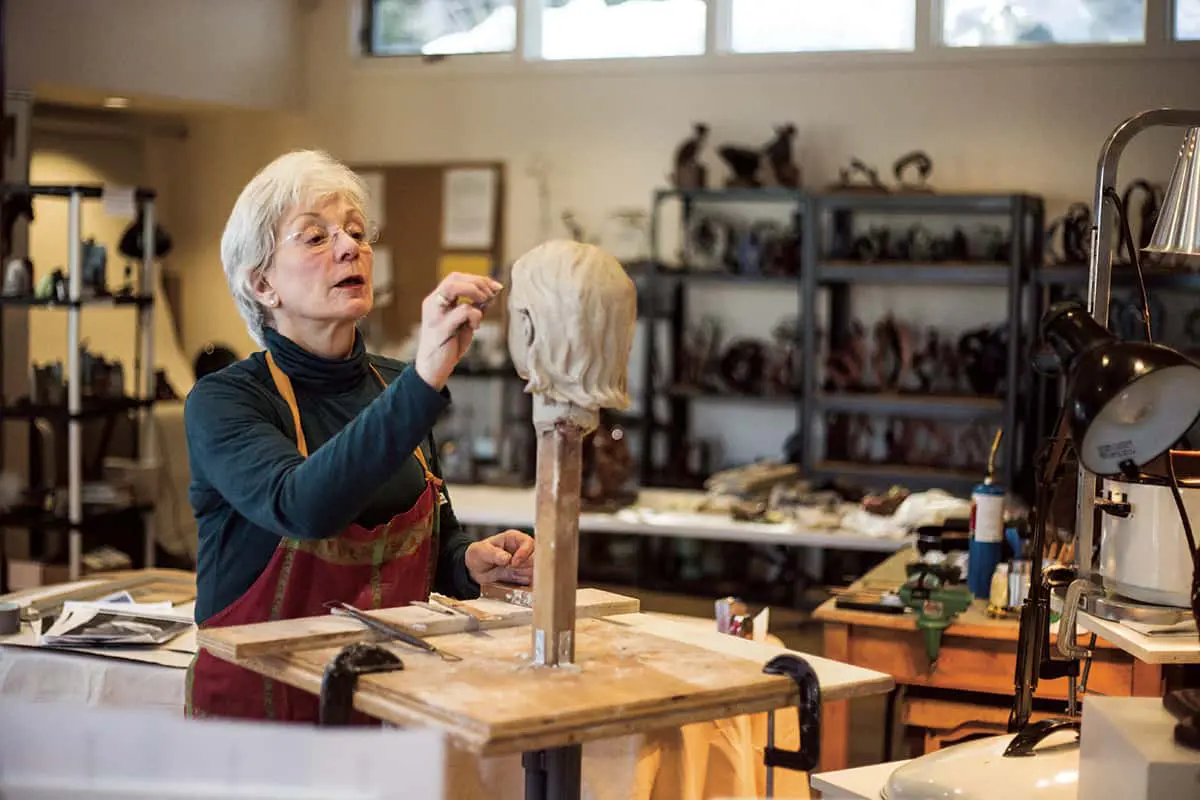By Deb Barracato // Photography by Ryan Dorgan
–
Spring, the season of renewal, sends many people into cleaning frenzies as they dust and declutter their homes. It’s also a great time to take stock of your career, polish your ambitions, and redefine your professional goals. Maybe you’re in a gratifying job but fear stagnation? Or maybe you’re ready for a complete overhaul? In either case, these four steps can tip you toward professional success and satisfaction.
STEP ONE:
Revamp Your Professional Image (aka “Your Brand”)
Your professional image starts with your resume and online profile. The pros at The Muse, an online career resource center, recommend that you keep your resume updated, even if you have no intention of applying for a new position. Why? Because a resume is an acceptable way to brag about your accomplishments. Maintaining a current one keeps your credentials at your fingertips, which you might need if you get nominated for an award or asked to speak at a conference. And when the dream job unexpectedly presents itself as a real possibility, bam, you’re ready to go.
Stefanie Schroeder, the director of human resources for Victor-based CityPass, recommends keeping your resume targeted and precise. Include only information that supports your qualifications for a specific position.
“Employers appreciate when a resume can convey the key skills and qualities in the most effective way,” she explains. For mid-career applicants, that means getting rid of the entry-level job from 20 years ago and the list of skills that should already be a given (such as proficiency with Microsoft Word).
Similarly, your LinkedIn profile should feel relevant and fresh. It’s not a set-it-and-forget-it tool. It’s basically an opportunity to network with other professionals without having to change out of your ski clothes. (You probably shouldn’t meet with a roomful of financial professionals in person, while wearing stinky Capilene®.) With the same thought, you want your online style to portray you as current and on-topic.
With the rapid growth of remote positions, crafted use of LinkedIn can lead you to opportunities that let you live the mountain lifestyle, while still pursuing your professional dreams. “A lot of people who want to live in mountain towns have specialized skill sets, but the employers there either don’t require those skills or can’t pay market value for them. So platforms like LinkedIn allow people to connect with possible employment outside of their geographical area,” explains Kristi Baughman, owner of Free Range Consulting in Victor and board vice president of Yellowstone-Teton Territory, a regional travel organization.
If you use Facebook, Instagram, Snapchat, or any other social platform professionally, the same ideas apply.
So how do you fill in the blanks on your profile? LinkedIn includes fields for volunteer experience and professional affiliations because those types of involvements increase your perceived value. You earn business clout for getting out in the community, connecting with other professionals, and strengthening your leadership skills. Nonprofits abound in the remarkably philanthropic communities of the Tetons, and nearly any one would welcome your volunteer effort.
Since 2006, the Jackson nonprofit Womentum has been giving Teton women an opportunity to pursue personal growth within a much broader social network than they would have in their normal day-to-day interactions. Though it’s not focused on professional development, the program encourages participants to set goals and develop personal leadership skills that can increase professional confidence. This type of networking experience often leads to career clarity and opportunities, explains the organization’s program director, Caryn Daus Flanagan.
STEP TWO:
Assess Your Motivations and Passions
Wilson sculptor Amy Bright Unfried came into her second career after aptitude testing revealed her natural ability to think in 3-D. She started her professional life in the financial field, but decided to stay at home with her children while they were young. When the last was nearing school age, Bright Unfried looked toward a new direction, unsure of where she wanted to focus her energy, but sure she did not want to return to her previous role.
Friends led her to Johnson O’Connor, a research foundation that conducts aptitude testing. She spent three happy half-days undergoing extensive testing that uncovered her extremely strong spatial skills. “They did not tell me there was just one thing. In fact, I had many aptitudes and some that perfectly fit my financial background,” Bright Unfried explains. “But the key was three-dimensional visualization.”
That revelation led her into a four-year process of experimentation, in which she explored disciplines ranging from sculpture to architecture to painting and etching and theater design. She even bought a little fixer-upper house to flip, doing a lot of the work herself. But when the market fizzled, it took the fun out of the project.
At the end of all of this, she was still taking sculpture classes. “It took me a long time to find my way into it, but once I got there I knew I could be happy [sculpting].”
Bright Unfried’s new career aligned with her life goals as well, which included plenty of time for family and the freedom to relocate from the East Coast to Jackson Hole. She recommends this sort of assessment for anyone looking for career direction, but especially for those in mid-career who may need to revitalize their interest and engagement in work. “If you’re frustrated with what you’re doing and have not been fulfilled, it’s a wonderful thing to find out something [about yourself] that can help you [change direction].”
Aptitudes—your innate abilities—differ from your affinities, or your natural liking for things. Maybe you have a talent for numbers, good analytical reasoning, and a love of the outdoors. And you also feel strongly about sustainability. If so, you would likely do well with a GIS (geographic information system) career. When you can figure out how to align your strengths and interests with your personal values, you’ll gain the most satisfaction from your career.
STEP THREE:
Learn Something New
When you execute the same duties day in and day out, your job can quickly start to feel rote. While there’s undeniable appeal in being able to perform with confidence, too little of a challenge and it goes stale. Combat complacency by learning something new. It may be a skill that helps you grow in your present job, or the foundation for an entirely different qualification that could lead you to a new career.
Many employers conduct periodic skills training with their employees, but you can also self-motivate and use local resources for continuing education. Outreach programs in the Tetons—both Central Wyoming Community College and Eastern Idaho Technical College—conduct in-person and distance learning courses for personal and professional enrichment.
Seasonal hospitality workers who want to segue into something more permanent can earn an associate degree in culinary arts or hospitality management through CWC. The school, located in the Center for the Arts, also offers nursing, accounting, and administrative assistant degrees.
Online training and tutorial courses from companies such as Lynda.com, Udemy, and Coursera cover an encyclopedia of topics, allowing you to maximize your ability to use a software program such as Excel or learn about Buddhism, all while lounging on the couch in your jammies.
STEP FOUR:
Consider Entrepreneurship
And then there’s the holy grail of business success: owning your own. While it takes a certain mettle to thrive as an entrepreneur, those who have it gain great satisfaction from being their own boss. Silicon Couloir, a Teton-based nonprofit, helps dreamers become doers with targeted mentoring programs, networking events, and educational resources. Scott Fitzgerald, the organization’s executive director, encourages anyone who wants to start, grow, or simply maintain a business in the Tetons to get involved with one or more of their programs.
In partnership with CWC, Silicon Couloir developed The Start-Up Intensive—a 10-week “business boot camp” led by a former assistant dean of the Harvard Kennedy School—with annual spring and fall sessions. The intensive curriculum covers key business considerations, including strategic planning, budgeting, developing target audiences, and conducting research to optimize product positioning. Fitzgerald likens it to a micro-MBA program, with a look at high-level theory but a deep dive into practical applications. Students walk away with key business plan elements and an “elevator pitch.”
If all goes well, you might get a chance to test that new pitch at Pitch Day, an annual event for a curated group of local entrepreneurs to present their idea to a panel of experienced judges. An open application period considers anyone launching or scaling a business idea that already has momentum and traction. Those chosen to participate undergo a five-week coaching period prior to the August event, where they compete for cash prizes, business coaching services, and invaluable feedback from the judges and audience members. Don’t have a business to promote but feel drawn to the idea of entrepreneurship? Join the audience; it’s an inspirational and motivational event for spectator,s too, says Fitzgerald.



